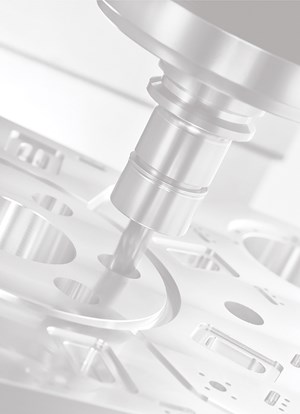Compact, Big-Bore Turning Center Provides 2.5" Bar Capacity
Haas Automation has expanded its line of big-bore turning centers with the smaller ST-15 model designed to provide more bar capacity without the space requirements of a larger-footprint lathe.
Share



Haas Automation has expanded its line of big-bore turning centers with the smaller ST-15 model designed to provide more bar capacity without the space requirements of a larger-footprint lathe. The turning center’s A2-6 spindle nose has a 3.5" (88.9-mm) bore and a 2.5" (63.5-mm) bar capacity. The machine offers a maximum cutting capacity of 14" × 16" (356 × 406 mm), with a swing of 16" (406 mm) over the cross-slide. It is equipped with an 8.3" (210-mm) hydraulic three-jaw chuck and a 12-station BOT turret.
The 20-hp (14.9-kW) vector dual-drive spindle turns at speeds ranging to 4,000 rpm and provides 150 foot-pounds (203 Nm) of torque. On-the-fly wye-delta switching yields a wide constant-horsepower band for constant surface-feed cuts, and rapid traverse rates of 1,200-ipm (30.5-m/min.) along with fast turret indexing help to reduce cycle times.
The turning center is said to be rigid, highly accurate and thermally stable. The spindle head features a compact, symmetrical design for thermal stability and rigidity, and the 45-degree wedge design increases the tool-mounting envelope and improves chip flow. Additional machine features include rigid tapping, a 15" color LCD monitor and a USB port. Available high-productivity options include a belt-type chip conveyor, a tailstock with hydraulic quill, an automatic tool probe, high-pressure coolant systems and more.
Related Content
-
3 Trends From PMTS 2025
The 2025 Precision Machining Technology Show provided an excellent look at the variety of machining solutions catering to the U.S. metalworking industry, including a range of automation solutions for turned and milled parts.
-
A History of Precision: The Invention and Evolution of Swiss-Style Machining
In the late 1800s, a new technology — Swiss-type machines — emerged to serve Switzerland’s growing watchmaking industry. Today, Swiss-machined parts are ubiquitous, and there’s a good reason for that: No other machining technology can produce tiny, complex components more efficiently or at higher quality.
-
How I Made It: Aneesa Muthana
Aneesa Muthana grew up helping out at her parents’ Chicago grinding shop before striking out on her own in the ‘90s. When business slowed down dramatically, she embraced change and built her machine shop into a modern facility using Swiss-type CNC machines.__PRESENT










-02.jpg;maxWidth=300;quality=90)

 (1).png;maxWidth=300;quality=90)





